Note: This website was automatically translated, so some terms or nuances may not be completely accurate.
What girls need now is "empowerment." The shock felt during an inspection of disaster-stricken Nepal. What kind of social action can be achieved through fashion?

Audrey Ayaka

Rei Mano
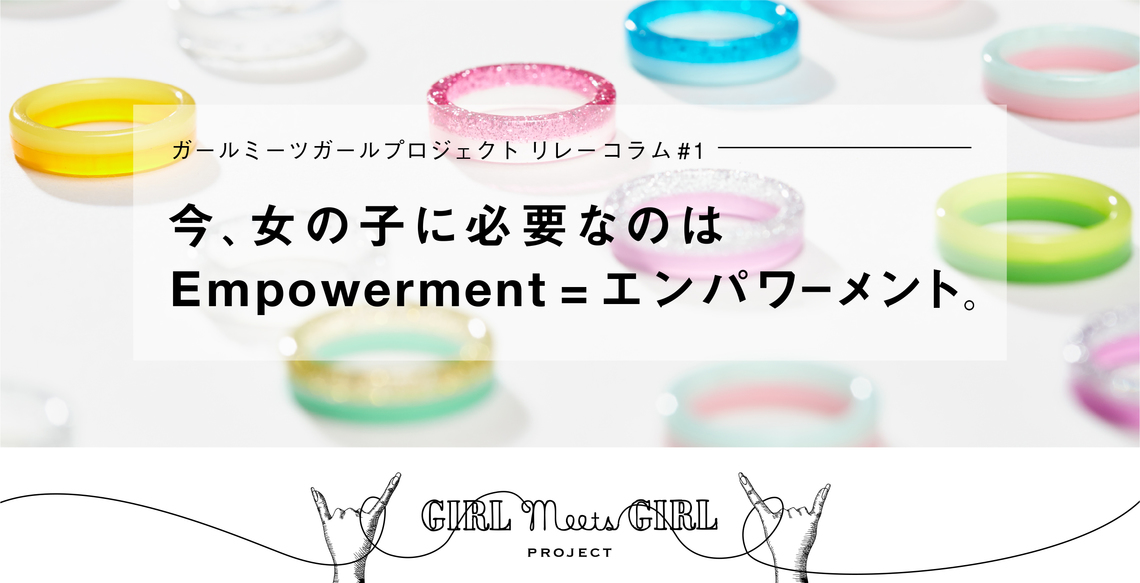
The Girl Meets Girl Project celebrates its 5th anniversary this year. This initiative, run by Dentsu Inc . Gal Lab and the international cooperation NGO JOICFP, has undertaken various activities to support women in developing countries.
A flagship initiative is the "Charity Pinky Ring" project. This fashion-forward item makes charity participation accessible to anyone. Of the ring's 500 yen retail price, 200 yen supports girls in developing countries. To date, it has sold 110,000 rings, raising over 13 million yen in donations.
This Charity Pinky Ring is steadily gaining popularity, especially among young girls. To turn this into an even larger movement, we created a new ring in collaboration with fashion model Audrey Ayaka. First, we visited Nepal, the beneficiary of the ring sales. Together with Audrey, we considered what "Girls Empowerment" truly means and is needed there now.
"Empowerment" might not be a familiar term in Japan yet.
Empowerment. Do you know this word? It might still be unfamiliar in Japan. But in fact, it's already a commonly used term in Western countries. Empowerment means "having the right and ability to determine one's own life and circumstances, participating in decision-making processes at various levels, and possessing the power to change one's social, economic, and political situation."
Originally meaning "to grant ability or authority," it began being used as a concept in social work around the 1970s. Today, it is primarily used to mean "improving social status." Unlike the simple meaning of "power," it might be a bit difficult to translate directly into Japanese.
The empowerment we aim for is about girls using their own power to expand their own possibilities. This time, we visited Nepal to empower girls there.
Fashion model Audrey Ayaka and I traveled to Nepal's disaster-affected areas.
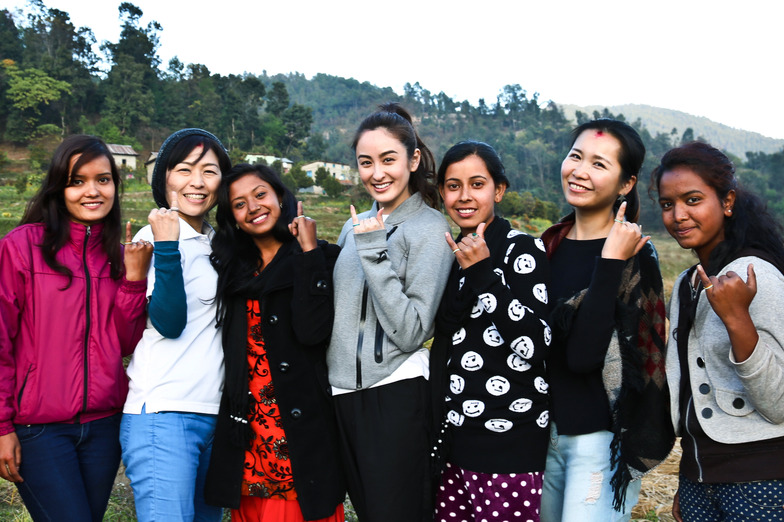
From left: Sabina, Joycef Ono, Asita, Audrey, Kurna, Dentsu Inc.'s Manno, Kusun
December 2015. We visited Nepal with Audrey Ayaka, an exclusive model for JJ magazine. Audrey, who strongly wished to create charity pinky rings with us this time, wanted to see the area with her own eyes and convey her feelings to JJ readers. So we headed to Nepal's earthquake-affected areas, one of the locations supported by the international cooperation NGO JOICFP.
Audrey, who graces JJ's covers with her glamorous looks—what kind of person is she really? What if she's super flashy? I was a little nervous, but the moment we met at Haneda Airport, those worries vanished. "Nice to meet you! Please call me O-chan!" she said with a friendly smile. The gap between her appearance and the simple nickname "O-chan" made her instantly approachable.
"I'm not very good at Japanese yet~," she said. She's a 26-year-old half-American, half-Japanese woman. Six years ago, driven by her dream of "becoming a magazine model in Japan! I want to walk in Tokyo Girls Collection!", she left the United States, where she was born and raised, and came to Japan. She struggled at first, knowing almost no Japanese, but achieved her dream in just two years—a true dream girl. Yet, despite her glamorous looks, she's surprisingly serious. She thoroughly researched Nepal beforehand for this inspection. Together with her, we headed to the disaster-stricken areas of Nepal, the project's support destination.
After about 15 hours of connecting flights, we arrived in Nepal. Nepal is 5,166 kilometers from Japan, an inland country nestled between India and China, home to the Himalayas and Mount Everest. From the airport, we drove toward Kathmandu, the central city of Nepal. Skyscrapers and modern buildings were still scarce. Instead, there were tightly packed old buildings, people and cars moving about, and massive amounts of exhaust fumes. It was a colorful, charming, and beautiful cityscape.

"Nepal is wonderful!" Seeing the scenery from the car, both Audrey and I instantly fell in love with Nepal. However, throughout the city, we saw many houses collapsed due to the earthquake's impact and people still living in tent shelters.
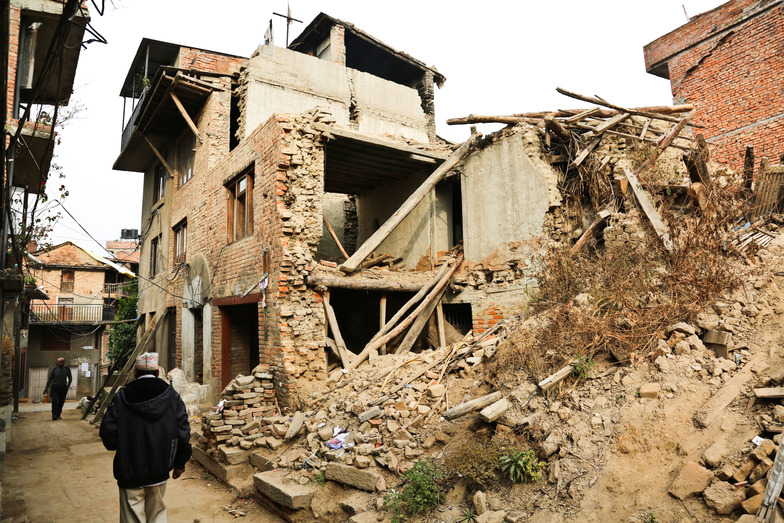
The photo shows Bungamati, a village near the capital Kathmandu that suffered the worst damage. It was once a historic village frequented by tourists. Now, however, there's no trace of that former charm; only collapsed structures are visible.
Indu, a 27-year-old villager, lost her home in the earthquake. "The government's reconstruction agency still hasn't been established, and there's no plan for redevelopment. Anyway, no one has any money, so rebuilding is difficult. That's why we have no choice but to continue living in shelters. Honestly, I'm worried about whether we can survive the coming cold winter," she shared, describing their difficult situation.
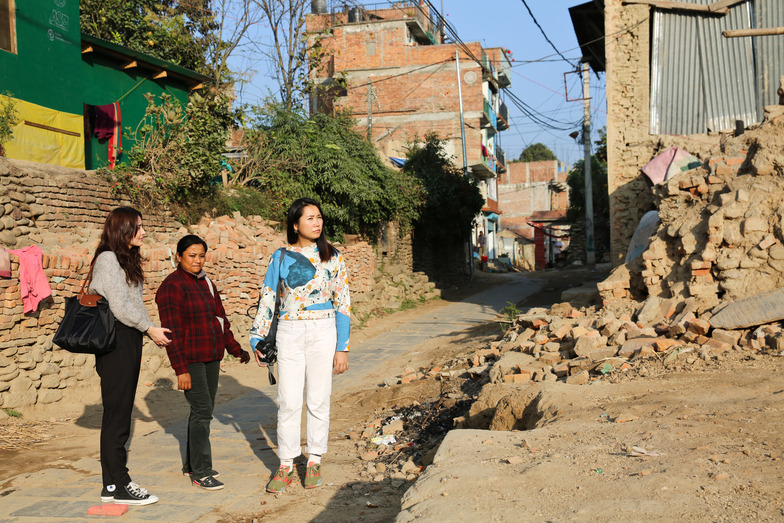
Next, we headed to a shelter within the disaster zone. Among the rows of tents where villagers live, there is a tent designated as a Female Friendly Space (women-only area). Here, in addition to distributing women-specific relief kits, counselors are stationed to provide counseling for women's concerns. We interviewed about the nature of the harm experienced.
The shocking reality: 81% of women in Nepal have experienced gender-based violence.
"Recently, we received a report of sexual violence against a 12-year-old girl. The perpetrator was her father. He had repeatedly sexually abused her since she was very young, on a daily basis. She couldn't speak up and hid it all this time, but she confessed after counseling at this shelter. Now, her father has been arrested, and she is being protected at a facility." It was a shocking fact.
What shocked me further was that such abuse is not particularly rare in Nepal. Astonishing data (Source: Nepal Preliminary Mapping of Gender Based Violence) indicates that in one region of Nepal, a staggering 81% of women have experienced "gender-based violence" on a daily basis.
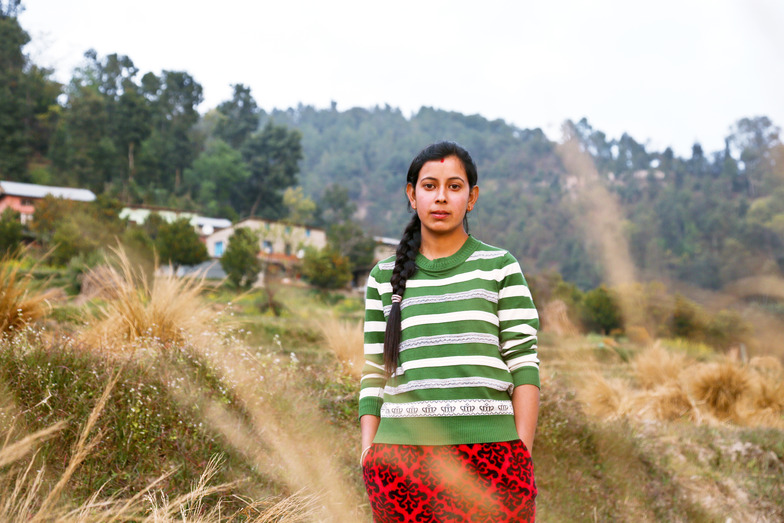
A major dark reality facing Nepal is the abnormally high incidence of gender-based violence against women. This refers to "violence caused by gender discrimination." It primarily includes physical punishment from men to women, psychological violence, and sexual violence such as incest. Numerous cases of gender-based violence, like this one, have been reported to surface after disasters. In fact, Japan also saw an increase in violence after the Tohoku earthquake.
What struck me here was the critical importance of "counseling." Problems within families are difficult to discuss with outsiders, especially in rural areas where communities are tight-knit and there are no third parties to consult. Unlike Japan, institutions like hotlines are underdeveloped; indeed, many regions lack even telephone access. In such developing countries, the presence of a trusted third party to consult is absolutely vital.
"If I had been born in Nepal, I might have become a sex worker too."

This time, I was able to speak with a 22-year-old woman in her room. She lives and works on the second floor of a restaurant. She isn't a waitress; she's actually a sex worker. While the restaurant is the front, it also serves as a brothel, bringing in clients to this room or sending them to hotels for sex work. Audrey conducted the interview in her room.
Audrey: How long have you been a sex worker?
Woman: About a year ago. It started when my husband ran away after we got married, and I struggled to make ends meet.
Audrey: Why did your husband run away?
Woman: We were from different castes under the caste system, and my parents opposed our marriage. But he begged me, saying his parents didn't matter, that he couldn't live without me, so we got married. But after we actually married, he still couldn't convince his parents. So he abandoned me and went overseas to work. Now I can't even reach him by phone, he doesn't reply to emails, and I've lost all contact.
Audrey: Was there no other way to work besides being a sex worker?
Woman: Of course, I never wanted this job. But it's the only way I can survive. Before meeting my husband, I lived in constant hardship. My parents abused me as a child, so I was sent to live with my uncle. There, I was made to work from morning till night, barely able to attend school. It was incredibly painful. I even tried to kill myself. But I couldn't go through with it. One day, I ran away from my uncle's house, clutching some small change. That's when I met my husband, while I was wandering the streets. But now he's abandoned me too. I have no home to return to, I never went to school, so of course I can't get a decent job.
Audrey: Is that your husband's photo you have in your room?
Woman: Yes. Honestly, I'm still waiting for him to come back. I hate him so much I could kill him, but if he returns, I plan to forgive him.
--: She also showed me a scarf she knitted for her husband. What did Audrey feel after talking with her?
Audrey: Honestly, I was shocked. If I'd been born in Nepal, I might have ended up as a sex worker too. That's how harsh the reality is for women—no place to work, no chance to do what they want. But seeing girls who've just accepted this reality made me so frustrated—I wanted to scream, "Don't give up!"
Don't limit your dreams! Dream bigger and bigger! Because every girl I met was smart, spoke English, and had so much potential—it's such a waste. Of course, there are many societal issues that need solving too. But above all, I think the most important thing is for the girls themselves to empower themselves through their own strength.
After this visit, the word "empowerment" came from Audrey's mouth. In fact, every Instagram post she made during her stay had the hashtag "#womanempoweringwoman." "Empowerment." That was the moment that word became the key to this project.
What developing countries need. It's support focused on "empowerment."
What can we do to empower girls? Specifically, what kind of support do you think is needed? When we think of aid, images of tangible material support might come to mind, like "for 100 yen, you can provide XX." But what this project truly values isn't just providing goods; it's whether the support genuinely "empowers" the local people.
At the international cooperation NGO JOICFP, we focus on training peer educators in developing countries to spread accurate knowledge and information about sexuality within youth communities.
Saving youth requires youth. The role of "peer educators."
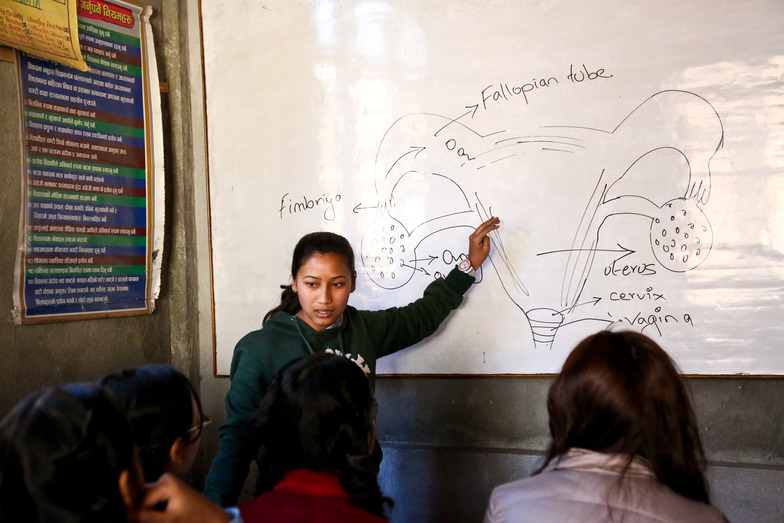
This time, these "peer educators" also participated in teaching sex education classes at a girls' school. In Japan, don't you get the image that kids who get involved in social initiatives like this during adolescence tend to be the serious, quiet class representative types? The flashy kids who are the center of the class definitely wouldn't do something like being a peer educator. But in Nepal, it's different. Becoming a peer educator is something everyone aspires to. They're all smart girls with great fashion sense, who have clear dreams and opinions of their own.
They draw diagrams of the uterus on the blackboard and explain the menstrual cycle in a very clear and understandable way. The middle school girls all listen with serious, focused expressions. Seeing this scene, I was deeply moved and thought it was wonderful. Topics like pregnancy, menstruation, and contraception are far more interesting and easier to ask questions about when taught by peers (friends) rather than by adults or male teachers. This method is something Japan, where sex education is lagging behind, should really learn from!
The local NGO "IPPF Nepal" (Nepal Family Planning Association), which collaborates with JOICFP, trains about 430 peers annually. Currently, there are around 4,000 active peers, and they have trained a total of 14,160 peers to date. Becoming a peer educator involves learning all aspects of sexual education to prevent unwanted pregnancies (including the mechanisms of pregnancy, STIs, etc.). The training goes beyond just learning; it includes the peer educators themselves thinking about how best to convey this information to their peers and how to express it most clearly.
While sex education is mandatory in Japanese schools, in developing countries, many people cannot attend school, and many girls drop out. This makes the work of peer educators crucial. The international cooperation NGO JOICFP focuses on training peer educators not only in Nepal but also in Tanzania, Zambia, Cambodia, and other countries.
A portion of the proceeds from this charity pinky ring will support global initiatives including peer educator training, human resource development, and providing learning spaces for them. In Nepal, funds will also go toward rebuilding the peer educator youth center (a training facility) destroyed by the earthquake.
The actions of Japanese girls who purchase these rings directly support girls in developing countries. "Preventing unwanted pregnancies," "protecting themselves from STIs and HIV." Promoting sex education for girls in developing countries is vital support that protects their very lives. Only by gaining the knowledge to protect their own bodies—their weapon—can these girls empower themselves, no matter their circumstances.
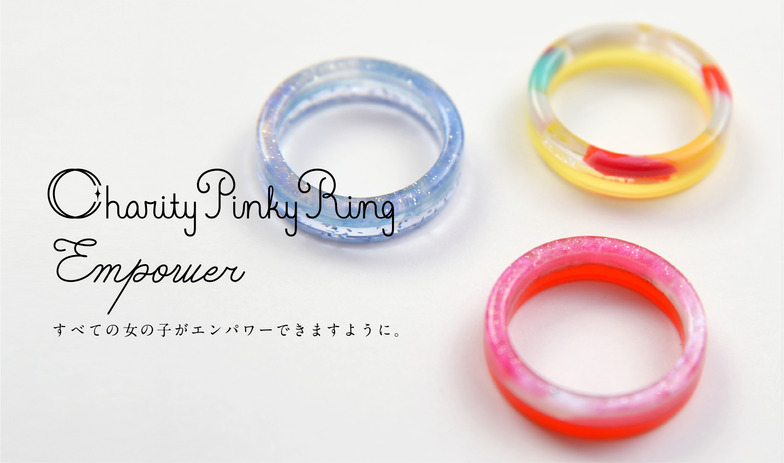
This time, we met many girls in Nepal and learned about Nepal's reality. We want Japanese girls to feel this reality not as something far away across the sea, but as something close to home. Through the 110,000 charity pinky rings sold so far, many Japanese girls have supported this project. Moving forward, we want to expand this circle and take it one step further: we want Japanese girls to take a deeper interest in this social issue.
For example, learning about peer educators can also prompt Japanese girls to consider their own reproductive health and rights. Japan is a developed nation. Yet, it's actually the only developed country where HIV infection rates are increasing—a nation, you could say, lagging behind in sex education. I believe developed countries shouldn't just offer condescending aid to developing nations; there are lessons and insights to be gained within this dynamic.
"Empowering Japanese girls themselves while supporting girls around the world through the Ring." With this grand goal, the Girl Meets Girl Project will continue its activities!
To be continued in the next column
Charity Pinky Ring Sales Site (Available at JOICFP Shop starting March 7. Pre-orders now being accepted)
Was this article helpful?
Newsletter registration is here
We select and publish important news every day
For inquiries about this article
Author

Audrey Ayaka
Fashion model
Born September 25, 1989, in California, USA. Half-American (father) and half-Japanese (mother). Auditioned in the US and began working in Japan at age 19. Since 2009, she has been active as an exclusive model for "JJ" (Kobunsha). In 2013, she appeared in "World Girls' White Paper". In December 2015, she visited Nepal, a country supported by JOICFP. Following the Nepal visit, she also created a new pinky ring. She actively participates not only as a fashion model but also in social contribution activities.

Rei Mano
Brand Director / Art Director
After graduating from Musashino Art University's Department of Visual Communication Design, she worked as an art director at Dentsu Inc. Beyond advertising, she has handled various social projects including the SEXOLOGY project, Hajimemabako, and the Charity Pinky Ring. Since 2022, she has been working independently as a freelance art director. Specializing in fashion, beauty, and education, he produces comprehensive brand design from product development to digital. He also promotes food culture centered on ethical and healthy themes, including launching his own brand, Romantic Foodies. https://romanticfoodies.com